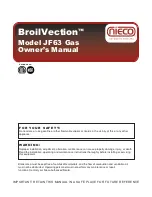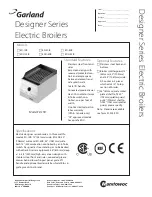
10
Boiler room of power over
25 kW to 2000 kW
should
have an air-
supply channel
with a cross-section not smaller than 50% of the
chimney’s section area, but not less than 20x20 cm.
The outlet from the
exhaust duct should be located not higher than 1.0 m from the level of
boiler-
room’s floor.
The boiler room should also have an
air exhaust channel
with a
cross-section not smaller than 25% of the
chimney’s section area, with
inlet under the ceiling of the boiler room, lead out to the roof and located
next to the chimney, if possible. The chimney's cross-section of this duct
should be not smaller than 14x14 cm.
Pressure and exhaust ventilation holes should be covered by means
of a steel mesh.
Note!
It is forbidden to use mechanical exhaust ventilation in the
boiler room.
Hint!
The boiler room should be equipped with day and artificial lighting.
Danger!
The inflow of a sufficient amount of fresh air to the boiler
room should be ensured.
Lack of sufficient inflow of fresh air can cause the so-called
incomplete combustion and formation of carbon monoxide.
7.3.
LOCATION OF THE BOILER IN A BOILER ROOM.
DWS
boilers do not require special foundations; correct boiler
leveling is, however, necessary. Leveling of boiler is possible thanks to
adjustable legs - extra paid equipment. The installation method is
presented in picture 20 on page 38.
It is recommended to locate the boiler on a concrete foot-pace of a
height of 20 mm. If the boiler is located in the cellar, it is recommended to
place it on a wall base with a minimum height of 50 mm. If there is no risk
of underground water inflow, the boiler can be located directly on a non-
flammable floor.
Foundation strength and fire-fighting requirements are to be
considered when locating a boiler:
•
during installation and operation, the boiler should be located at least
200 mm from flammable materials,
•
for C
3
flammable materials, which burn quickly and easily even after
removal of the fire source, this distance is two times bigger and should be
equal to at least 400 mm,
•
if fire rating is not known, for safety reasons the distance should also be
doubled.
Table 5. Fire rating for building compounds and materials.
Fire rating for
building
compounds and
materials
Building compounds and materials
A-non-flammable
sandstone, concrete, brick, fireproof plaster, mortar,
ceramic tiles, granite
B-hardly flammable
wooden-cement boards, glass fibre, mineral insulation
C
1
-hardly flammable
beech wood, oak wood, plywood
C
2
-medium flammable
pine wood, larch wood, spruce wood, cork, sawn
wood boards, rubber carpet
C
3
-easily flammable
asphalt ply, celluloid mass, polyurethane, polystyrene,
polyethylene, plastic material, PVC
It is strictly forbidden to locate the boiler in wet or damp rooms as it
speeds up corrosion resulting in total damage of a boiler in a short time.
The boiler's distance from the opposite wall should not be smaller
than 2 m and the distance from the side walls should not be smaller than
0.5 m. An exemplary location of the boiler in a boiler room is presented in
pic. 4.
Picture 4
.
Location of the boiler in a boiler room.
7.4.
CONNECTION OF BOILER WITH HEATING SYSTEM.
Central heating installation made should fulfill the requirements of the
standards and legal regulations currently in force, and detailed
regulations in the country of destination concerning the protection of
water heating devices in open or closed systems.
Note!
To ensure the correct operation of the boiler it should be
protected against the corrosion caused by the return of water
with temperature below the dew point from the central heating
system. The temperature of the water returning to the boiler
should have min. 55 ºC.
Failure to meet the above requirement would cause the loss
of warranty!
7.4.1.
COOPERATION WITH ACCUMULATION TANK
The task of the accumulation tank is a storage of excess of thermal
energy, connected with varying demands for heat. Energy generated
during the fuel combustion process is accumulated by the heating
medium in an insulated tank, which allows its further using for various
purposes e.g. for domestic hot water or central heating.
The advantage of the accumulation process, with respect to the system
without an accumulation tank, is a rational use of fuel energy and
therefore fuel savings up to 30%. It is connected with the efficiency of the
boilers, which usually achieve the highest efficiencies at nominal power.
The accumulation tank is intended to store periodical energy excess.
Water heated in the boiler flows through an accumulation tank
progressively charging the boiler. Accumulation lasts until the given
temperature is reached in the accumulation tank. Thermal insulation of
the tank ensures that the whole system is energy-saving. After damping a
boiler user may use the accumulated heat for several hours.
Note!
It is required for the boiler to operate with an accumulation
tank and thermoregulator. The minimum temperature of return
shall be equal to 55°C.
Failure to meet the above requirements causes loss of
warranty for the boiler!
≥
500mm
≥
500mm
≥
25
0m
m
≥
20
00
m
m











































